Vauxhall Firenza
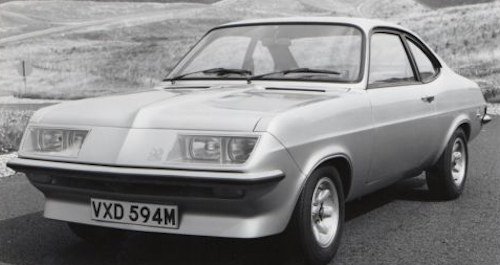 |
|
|
Production period: |
1970 to 1975 |
|
Class |
Sports car |
|
Body versions : |
coupe |
|
Engines: |
1159-2300 cc |
|
Length: |
4,135 mm |
|
Width: |
1,644 mm |
|
Height: |
1,341 mm |
|
Wheelbase : |
2,464 mm |
The Vauxhall Firenza was manufactured by Vauxhall from 1970 to 1975. This was derived from the Vauxhall Viva HC, but had a distinctly different from the sedan coupe body with two doors.
History
The Firenza was initially with 1159 cc four-cylinder OHV in-line engine and with 1598-cc four-cylinder OHC in-line engine.Later, both machines were enlarged to 1256 cc, or 1798 cc.
PERFORMANCE Firenza 1256
max power (SAE): 63 hp at 5,400 rpm
max torque (SAE): 71 1b ft. 9.8 kg m at 3,600 rpm
max engine rpm: 6,000; 50.3 hp/l
max speeds: (l) 27 mph, 43 km/h; (Il) 43 mph, 70 km/h; (Ill) 74 mph, 119 km/h; (IV) 82 mph, 132 km/h
power-weight ratio: 29.5 lb/hp, 13.4 kg/hp
speed in direct drive at 1,000 rpm: 15.5 mph, 25 km/h
fuel consumption: 33 m/ imp gal, 27.7 m/US gal, 8.5 1 x 100 km.
PERFORMANCE Firenza 1800
max power (DIN): 77 hp at 5,200 rpm
max torque (DIN): 97 1b ft, 13.4 kg m at 3,000 rpm
max engine rpm: 6,250; 43.7 hp/l,
max speeds: (l) 35 mph, 56 km/h, (II) 54 mph, 87 km/h (III) 84 mph, 135 km/h, (IV) 100 mph, 161 km/h
power-weight ratio: 25.8 lb/hp, 11.7 kg/hp
fuel Consumption: 27 m/imp gal, 22.4 m/US gal, 10.5 1.
On all models, the engine was installed at the front and powered the rear axle. The front suspension consisted of double wishbones and coil springs, the rear drive axle had trailing arm and also coil springs.
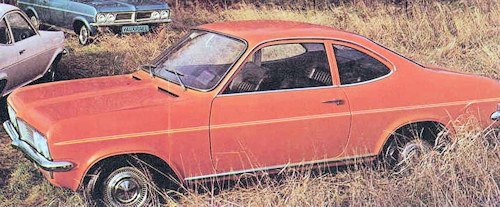
In 1973, Vauxhall decided that their rather boring range of models needed a refresher, and developed a version of the Firenza that was officially called "HP" (High Performance), but became widely known as the "droopsnoot" because of its dramatic aerodynamic nose , The front was made of fiberglass and contained Cibié headlamps, which were protected by shatterproof glass panels. The front design of the car reminded a little of the Renault Alpine A310 .
At the same time the normal Firenza model with shallow snout in Vauxhall Magnum Renamed Coupe and the name Firenza was used exclusively for the HP version. This car was an exciting styling approach for Vauxhall, and there were certainly different opinions about it. The engine was a 2.3-liter variant of the 4-cylinder OHC in-line engine, which was very powerful and developed 131 bhp (96 kW). It used many parts from Blydenstein Racing: It had a 175cc Stromberg carburetor, a high-build camshaft and a free-flow exhaust manifold.
Engine: 139.2 cu. in. (2279 c.c.), net b.h.p. 131.0 at 5500 r.p.m., compression ratio 9.2:1; 4-cylinder in line; cross flow cylinder head; single high lift overhead camshaft, belt driven; pre-engaged starter; twin 175 Stromberg carburettors; hand finished combustion chambers, valve ports and throats; 5-bearing crankshaft with over-lapping journals and extra-large bearings; viscous fan drive; mechanical fuel pump; pump pressurised cooling system; full flow oil filtration; 12-volt 39-amp./hr. battery; negative earth electrical system; heavy duty alternator.
PERFORMANCE Firenza 2.3-liter (standard)
max power (DIN): 110 hp at 5,200 rpm
max torque (DIN): 140 1b ft, 19.3 kg m at 3,000 rpm
max engine rpm: 5,500; 47 hp/l;
max speeds: (l) 36 mph, 58 km/h; (II) 56 mph, 90 km/h; (III) 89 mph, 143 km/h; (IV) 104 mph, 167 km/h
power-weight ratio: 18.7 lb/hp, 8.4 kg/hp
acceleration: standing 1/4 mile 18 sec, 0-50 mph (0-80 km/h) 8.3 sec
fuel consumption: 25 m/ imp gal, 20.8 m/US gal, 11.3 1 x 100 km.
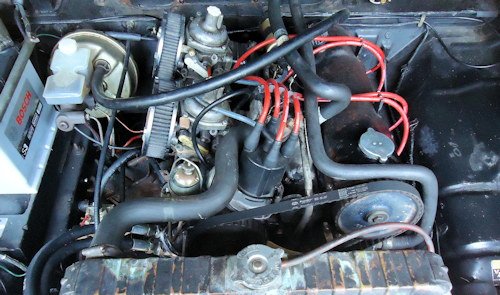
The car was designed by a US designer, Wayne Cherry, and had a very low drag coefficient for that time. The chassis has been revised and lowered, the brakes revised and installed a 5-speed ZF transmission. All this led to a much stronger (albeit louder) drive than the standard model. Another unusual feature of the vehicle was its aluminum AVON wheels, which were designed to hold the tire securely on the rim during a puncture. The Firenza was the first production vehicle to use this technology. All series Firenza were painted in the same color - "Silver Starfire" - and had a mostly black interior with silver-gray, fabric-covered seats. A somewhat dubious trim detail was the passenger's handle, which was attached to the dashboard instead of the glove box. All series Firenza were painted in the same color - "Silver Starfire" - and had a mostly black interior with silver-gray, fabric-covered seats. A somewhat dubious trim detail was the passenger's handle, which was attached to the dashboard instead of the glove box. All series Firenza were painted in the same color - "Silver Starfire" - and had a mostly black interior with silver-gray, fabric-covered seats. A somewhat dubious trim detail was the passenger's handle, which was attached to the dashboard instead of the glove box.
Mechanically operated clutch 9.5 in. (242 mm.) diameter; 5-speed ZF all synchromesh gearbox, floor-mounted gearshift, ratios: 2.99, 1.76, 1.30, direct 0.87:1; final drive ratio 3.7:1; rack and pinion steering; independent front suspension by coil springs and wishbones; rear live axle mounted on coil springs and controlled by 4-link system;
front anti-roll bar; dual circuit braking system with 10.1 in. (255 mm.) front discs and 9.0 in. (229 mm.) self-adjusting rear drum brakes; vacuum servo; central floor mounted hand brake; 185 70HR-13 radial-ply tyres on cast alloy road wheels with Avon Safety rims 6.0 in. (152 mm.) wide; 3 constant velocity joints in 2-piece propeller shaft.
Fitted with the following equipment, aero-dynamic nose cone made of glass; reclining individual front seats with restraining catches; superior cloth trim; carpet floor trim; boot mat; front and rear ashtrays; interior roof lamp with integral and door courtesy switches; fully adjustable face level vents with rear air extraction; steering column levers controlling head lamp flasher/dip/direction indicators, horn and electric screenwash/2-speed wipers; fitted front inertia reel seat belts and rear seat anchorages; energy absorbing steering column; anti-burst door locks and hinges; free wheeling door lock buttons; twin sun visors; knock-out shatterproof interior rear view mirror; double handed steering column lock; glovebox; front and rear parcel shelves; heater and demister with 2-speed blower fan; water temperature gauge; trip speedometer; handbrake and fluid loss warning light; rev. counter; clock; ammeter; oil pressure gauge; special sports steering wheel; front passenger grab handle; front armrests with integral grab handles; twin trumpet horns; boot light; illuminated heater controls.
The griffin front end decal; Firenza rear end panel badge; laminated windscreen; twin Halogen head lamps; bumpers painted in body colour; finished in 'Magic Mirror' Acrylic Paint. Colour scheme: Sebring Silver Starfire Metallic with Onyx trim.
OPTIONAL ACCESSORIES G.M. automatic transmission, hydraulic torque converter and planetary gears with 3 ratios
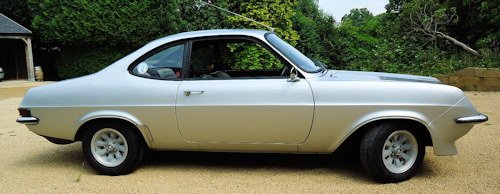
The car was a design highlight for Vauxhall, but also a sales flop. There was a lot of advertising on the occasion of a special race in Thruxton in Hampshire presented and driven by well-known drivers like Gerry Marshall and Barry Williams. Barry Williams also won the race. Even so, given the rampant oil crisis, it was difficult to sell cars with such unrestrained gas mileage, even though the aerodynamic muzzle significantly reduced gas mileage already, because about 30 bhp was less needed to reach top speed. This, combined with some difficulties with the production line, kept production and sales figures low. Probably only 204 pieces were built, far less than the 30,000 targeted specimens. This very low volume was of course a disaster for Vauxhall, but that made this vehicle a cherished classic, which ensures its survival better than that of some standard production vehicles, which were produced at the same time and are now harder to find.
In South Africa, the Firenza was manufactured at General Motors South Africa as Chevrolet Firenza . As a special model was also the Chevrolet Firenza CanAm (also called Little Chev ) provided with the 5 -liter V8 engine of the Camaro and built for homologation purposes in 100 copies. With 290 hp accelerated exclusively in white with black bonnet vehicles accelerated to a top speed of about 230 km / h.
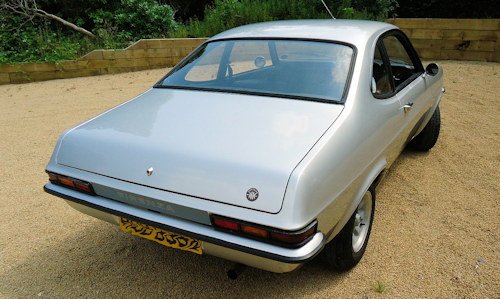
Technical
-
Vauxhall Firenza Technical details and specifications (1970-1975)
ENGINE Firenza 1256
front, 4 stroke
4 cylinders, vertical, in line
76.6 cu in, 1,256 cc (3.19 x 2.40 in, 81 x 61 mm)
compression ratio: 8.5:1
cast iron cylinder block and head
3 crankshaft bearings
valves: overhead, in line, push-rods and rockers
camshafts: 1, side
lubrication: gear pump, full flow filter5.5 imp pt, 6.6 US pt. 3.1 1;
1 Zenith IZE down-draught single barrel carburettor
fuel feed: mechanical pump
water-cooled10.2 imp pt, 12.3 US pt, 5.8 1.ENGINE Firenza 1800 SL
4 cylinders, in line
107.3 cu in, 1,759 cc (3.38 x 3 in, 85.7 x 76.2 mm)
compression ratio: 8.5:1
5 crankshaft bearings
camshafts: 1, overhead, push-rods, cogged belt
lubricating system capacity: 8.5 imp pt. 10.1 US Pt. 4.8
1 Zenith 36 NE downdraught single barrel carburettor
cooling system capacity: 14.1 imp pt, 16.9 US pt, 8 1.ENGINE Firenza 2.3-liter
139.1 cu in, 2,279 cc (3.86 x 3 in, 97.5 x 76.2 mm)
max engine rpm: 5,500; 47 hp/l; 2 Zenith Stromberg 175 CD-2 sidedraught single barrel carburettors.
TRANSMISSION
driving wheels: rear
clutch: single dry plate (diaphragm)
gearbox: mechanical
gears: 4, fully synchronized; ratios: 1 3.460, II 2.213, III 1.404, IV 1, rev 3.707;
final drive: hypoid bevel
axle ratio: 4.125
axle ratio: 3.455
width of rims: 4"
tyres: 5.60 x 13. width of rims: 5" tyres: 175/70HR x 13.(2.3L)
CHASSIS
integral
front suspension: independent, wishbones, coil springs, telescopic dampers
rear suspension: rigid axle, trailing lower radius arms, upper oblique radius arms, coil springs, telescopic dampers.
front suspension: anti-roll bar; rear suspension: anti-roil bar. (1800 SL)STEERING
rack-and-pinion
turns lock to lock: 3.16.
turning circle (between walls):4.1 ft, 10.4 mBRAKES
front disc (diameter 8.54 in, 217 mm), rear drum, servo
front disc (diameter 10.03 in, 255 mm), rear drum; servo (1800 SL)ELECTRICAL EQUIPMENT
12 V
32 Ah battery
444 W alternatar
AC Delco distributorDIMENSIONS AND WEIGHT
wheel base: 97 in, 2,464 mm;
Tracks: 51.40 in, 1,306 mm front, 51.50 in, 1,308 mm rear
length: 162.80 in, 4,135 mm
width: 64.70 in, 1,644 mm
height: 52.80 in, 1,341 mm
ground clearance: 5 in, 127 mm© Motor car History
Service
-
Vauxhall Firenza Service Guide (1970-1975)
fuel: 98 oct petrol
engine sump oil: 4.9 imp pt. 5.9 US pt, 2.8 1, SAE 20W-20, change every 1,000 miles, 9,700 km
engine sump oil: 8 imp pt, 9.5 US pt, 4.5 1, 1OW-40, change every 6,000 miles, 9,700 km (1800)
engine sump oil: 8.5 imp pt, 10.1 US pt, (2.3L)
gearbox oil: 0.9 imp pt, 1.1 US pt, 1, SAE 90, change every 6 months
final drive oil: 1.2 mp pt. 1.5 US pt, 0.7 1, SAE 90, no change recommended
Greasing: every 6 months, 4 points
tappet clearances: inlet 0.008 in, 0.20 mm, exhaust 0.008 in, 0.20 mm
tappets clearances: inlet 0.007-0.010 in, 0.17-0.25 mm, exhaust 0.015-0.018 in, 0.37-0.45 in (1800)
valve timing: 39° 73° 71° 41°
tyre pressure: front 22 psi, 1.5 atm, rear 22 psi, 1.5 atm.
fuel tank: 8 imp gal, 9.5 US gal, 36 1
carrying capacity: 917 1b, 415 kg© Motor car History
